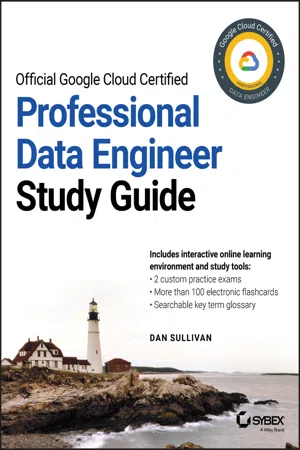
- English
- ePUB (mobile friendly)
- Available on iOS & Android
Official Google Cloud Certified Professional Data Engineer Study Guide
About this book
The proven Study Guide that prepares you for this new Google Cloud exam
The Google Cloud Certified Professional Data Engineer Study Guide, provides everything you need to prepare for this important exam and master the skills necessary to land that coveted Google Cloud Professional Data Engineer certification. Beginning with a pre-book assessment quiz to evaluate what you know before you begin, each chapter features exam objectives and review questions, plus the online learning environment includes additional complete practice tests.
Written by Dan Sullivan, a popular and experienced online course author for machine learning, big data, and Cloud topics, Google Cloud Certified Professional Data Engineer Study Guide is your ace in the hole for deploying and managing analytics and machine learning applications.
- Build and operationalize storage systems, pipelines, and compute infrastructure
- Understand machine learning models and learn how to select pre-built models
- Monitor and troubleshoot machine learning models
- Design analytics and machine learning applications that are secure, scalable, and highly available.
This exam guide is designed to help you develop an in depth understanding of data engineering and machine learning on Google Cloud Platform.
Frequently asked questions
- Essential is ideal for learners and professionals who enjoy exploring a wide range of subjects. Access the Essential Library with 800,000+ trusted titles and best-sellers across business, personal growth, and the humanities. Includes unlimited reading time and Standard Read Aloud voice.
- Complete: Perfect for advanced learners and researchers needing full, unrestricted access. Unlock 1.4M+ books across hundreds of subjects, including academic and specialized titles. The Complete Plan also includes advanced features like Premium Read Aloud and Research Assistant.
Please note we cannot support devices running on iOS 13 and Android 7 or earlier. Learn more about using the app.
Information
Chapter 1
Selecting Appropriate Storage Technologies
- Designing data processing systems
- ✔ 1.1 Selecting the appropriate storage technologies
- Mapping storage systems to business requirements
- Data modeling
- Tradeoffs involving latency, throughput, transactions
- Distributed systems
- Schema design
- ✔ 1.1 Selecting the appropriate storage technologies

- The business aspects of choosing a storage system
- The technical aspects of choosing a storage system
- The distinction between structured, semi-structured, and unstructured data models
- Designing schemas for relational and NoSQL databases
From Business Requirements to Storage Systems
- Ingest
- Store
- Process and analyze
- Explore and visualize
Ingest
- Application data
- Streaming data
- Batch data
Application Data
- Transactions from an online retail application
- Clickstream data from users reading articles on a news site
- Log data from a server running computer-aided design software
- User registration data from an online service
Streaming Data
- Virtual machine monitoring data, such as CPU utilization rates and m...
Table of contents
- Cover
- Title Page
- Copyright
- Dedication
- Acknowledgments
- About the Author
- About the Technical Editor
- Introduction
- Assessment Test
- Answers to Assessment Test
- Chapter 1 Selecting Appropriate Storage Technologies
- Chapter 2 Building and Operationalizing Storage Systems
- Chapter 3 Designing Data Pipelines
- Chapter 4 Designing a Data Processing Solution
- Chapter 5 Building and Operationalizing Processing Infrastructure
- Chapter 6 Designing for Security and Compliance
- Chapter 7 Designing Databases for Reliability, Scalability, and Availability
- Chapter 8 Understanding Data Operations for Flexibility and Portability
- Chapter 9 Deploying Machine Learning Pipelines
- Chapter 10 Choosing Training and Serving Infrastructure
- Chapter 11 Measuring, Monitoring, and Troubleshooting Machine Learning Models
- Chapter 12 Leveraging Prebuilt Models as a Service
- Appendix Answers to Review Questions
- Index
- End User License Agreement